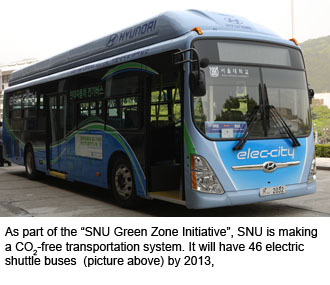 Until last year, all of SNU’s shuttle buses were yellow. Recently, a blue shuttle bus started running, which confused some students. The blue one runs the same route as the old yellow ones, so there is no need to hesitate to get on. The only difference is that the blue bus is an electric vehicle recently purchased as an effort to reduce CO2 emissions on campus.
Until last year, all of SNU’s shuttle buses were yellow. Recently, a blue shuttle bus started running, which confused some students. The blue one runs the same route as the old yellow ones, so there is no need to hesitate to get on. The only difference is that the blue bus is an electric vehicle recently purchased as an effort to reduce CO2 emissions on campus.
Since 2008, SNU has been carrying out the “Sustainable SNU Project,” under which there are 92 subprojects, 42 of which are currently being executed. Let’s take a look at some of SNU’s efforts.
The Ministry of Environment and SNU have been cooperating to reduce greenhouse gas emissions on campus. SNU is the first university in Korea to calculate the amount of greenhouse gases emitted within the boundaries of its campus. In 2008, it was 87,906tCO2-eq, and in 2009, it was 88,311tCO2-eq (CO2-eq means equivalent to CO2). This means the total amount of greenhouse gases emitted on campus is equivalent to 88,311 tons of CO2 in regards to its greenhouse effect. Although the gross amount of emissions increased, the amount of emissions per capita was reduced. By 2020, SNU plans to reduce its greenhouse gas emissions by 35%.
As part of the “SNU Green Zone Initiative”, SNU is planning to set up a CO2-free transportation system. This is where the blue shuttle bus comes in. With the financial support of the Ministry of Environment, SNU plans to supply 46 electric shuttle buses and 114 electric cars for business use by 2013. The electricity to charge the batteries will be generated partly through solar panels that will be installed on campus.
Buildings 220 and 500 are good examples of environment-friendly architecture. Building 220 has solar plates that generate energy for the lighting and water heating. Hydrogen batteries are installed in Building 500. Using these buildings as examples, SNU plans to develop guidelines for future buildings as well.
As an educational institution, SNU is doing its part to promote eco-consciousness among the younger generation. With the development of 15 “green classes,” SNU plans to educate students to become leaders that can confront and handle the problems that inhibit environmental sustainability.
For example, a class called “Green Energy” was offered this semester. Through this class, students could learn what the latest technologies in green energy are and how they are being used. Including “Green Energy,” three classes were already introduced this spring semester, and three to four classes are expected to be offered next semester.
Making SNU environmentally-friendly is not just a PR catchphrase. The university is making significant investments both financially and in terms of using its human resources to achieve this goal.
For example, the green transportation program alone costs 32.8 billion won. Fortunately, the university is receiving a great amount of support from the government and from private donations. However, there is one type of support that is crucial to the project’s success: participation. So next time you get on the blue shuttle bus with a cup of coffee in your hand, don’t forget to recycle it after you get off!
Written by KIM Jaeseung, SNU English Editor, brainophone@naver.com ?
Reviewed by Eli Park Sorensen, SNU Professor of Liberal Studies
Proofread by Brett Johnson, SNU English Editor

